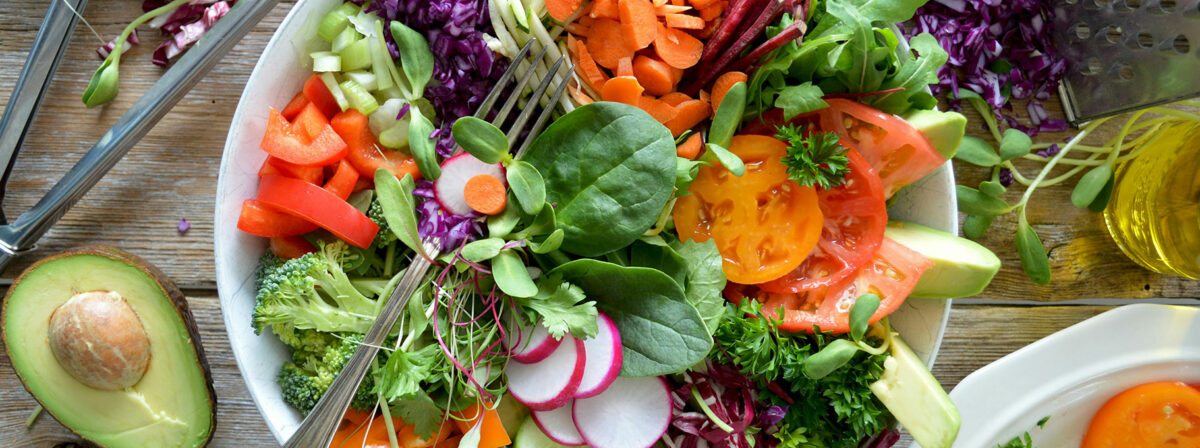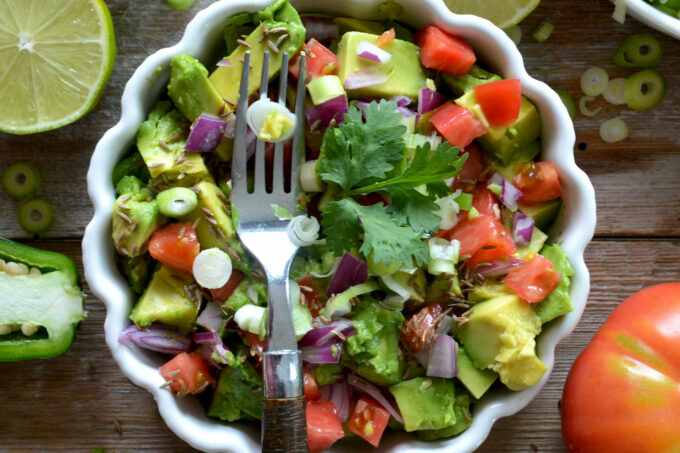“Vegetable” is a broad term that refers to the edible parts of plants, such as their leaves, (eg spinach, doodo, nakati, sukuma wiki, cabbage); roots (eg carrots, onions, garlic, beetroot), flowers (eg, broccoli, cauliflower) and fruits (cucumber, bell peppers, avocado, tomatoes, ntula – from a culinary perspective, fruits that have a mild or savory taste and are usually eaten as a side dish are classified as vegetables). Vegetables are high in nutrients, and it is therefore recommended that you consume vegetables daily. A diet that includes a diversity of vegetables is one of the components of a healthy lifestyle.
One of the primary reasons to eat vegetables everyday is that they improve digestive health because they are a good source of dietary fibre, which helps food pass through your digestive system. If you eat vegetables with every main meal, you are not likely to have constipation. The fibre in vegetables also gives them a low glycemic index, which means that your blood sugar will not rise quickly (or spike) after a meal. Thus, having vegetables at every meal can help in diabetes control. Fiber can also help reduce cholesterol and cardiovascular disease.
Vegetables are important sources of vitamins, minerals, and antioxidants that provide many important health benefits which can be loosely categorised according to their colours:
Dark green vegetables like doodo, nakati, spinach are good sources of iron, and if combined with citrus fruits can make an important contribution to iron intake and the prevention of anemia. They are also a good source of folate, a B vitamin that helps your body make new red blood cells. Folate is especially important in pregnancy to prevent neural tube defects (Spina bifida, hydrocephalus) and may also reduce the risk of cancer and depression. Cabbage and its relatives cauliflower, broccoli, brussels sprouts and sukuma wiki (all members of the cruciferous family) help reduce inflammation and the build-up of calcium in blood vessels, thus reducing the risk of heart disease. Green vegetables are also great sources of other essential nutrients like vitamin A, copper, magnesium, zinc, phosphorous and selenium.
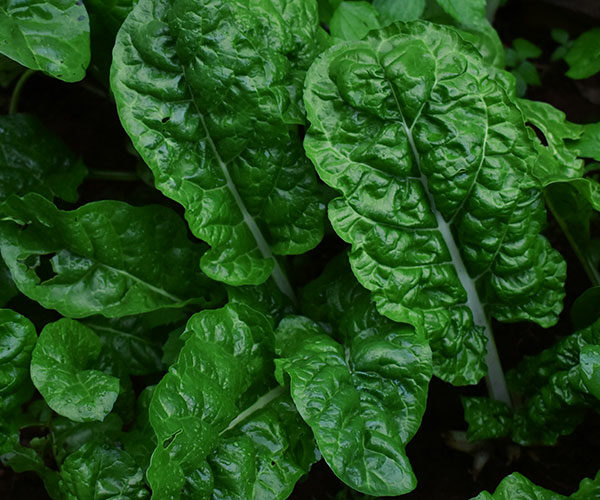
Orange- and yellow- coloured vegetables such as carrots and pumpkin are very high in beta carotene, from which we get vitamin A, which plays an important role in eye health and in immunity.
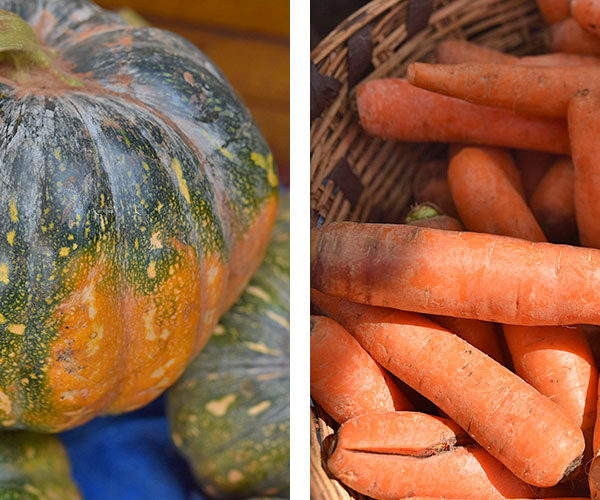
Red- and purple- coloured vegetables including tomatoes, egg plants and red/purple cabbage, get their colour from lycopene and anthocyanins. Lycopene is an antioxidant that has been shown to protect the eyes, fight infections, and protect against damage from tobacco smoke. Anthocyanins are antioxidants and may help reduce inflammation and provide protection from cancer, Alzheimer’s disease, heart disease, and type 2 diabetes.
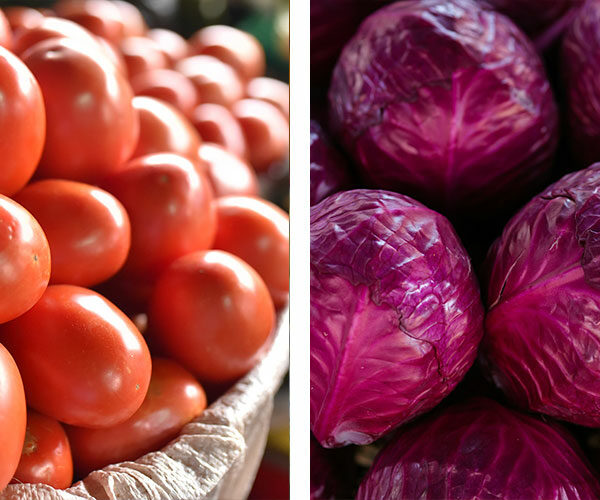
A diverse diet is a high-quality diet: eating vegetables with a variety of colours is one way of ensuring that your diet is diverse.
Phytochemicals
Vegetables (and other plant foods) contain a bonus called phytochemicals or phytonutrients. While they may not be necessary for human survival (like vitamins are), these phytochemicals offer impressive health benefits. Phytochemicals are part of the plant’s immune system and help protect the plant from viruses, bacteria, fungi and parasites. Phytochemicals can offer humans some of that same protection by protecting cells from damage caused by environmental toxins and the body’s natural chemical (metabolic) processes. Beta carotene, lycopene and anthocyanins are examples of phytochemicals. The benefits of phytochemicals include:
- Antioxidant properties that help with neutralizing free radicals, which would otherwise damage DNA, thus they can hinder the development of cancer.
- Improving immune function and reducing ongoing inflammation associated with inflammatory diseases.
- Supporting brain function, sleep and mental health
- Supporting heart health and preventing cardiovascular diseases by helping decrease inflammation, improving cholesterol absorption, preventing oxidative stress and reducing blood pressure.
In nutrition research, no matter what disease is being looked at, whether it’s heart disease or certain cancers, people who eat more vegetables have improved survival.
Tips to increase the amount of vegetables in your daily diet:
- Aim to have at least two types of vegetables with your usual staple.
- Request for a bigger portion of vegetables – we are usually served small amounts of vegetables – ask for more!
- Snack on carrot and cucumber sticks for a healthier break.
- When presented with options for side dishes, go for the vegetable option. For example, choose a vegetable salad over fries.
- Include green (vegetable) smoothies in your diet as one of the ways in which to consume vegetables.
Different Ways of Consuming Vegetables
Salads are a fresh and healthy way to enjoy your vegetables. However, note that oil-soluble phytochemicals such as carotenoids in carrots and lycopene in tomato are best absorbed with some dietary fat. A few drops of olive oil in your salad will therefore aid in your body’s absorption of these nutrients. Cooking your vegetables helps to break down tough outer layers and the cellular structure of many vegetables, making it easier for your body to absorb the nutrients. As a rule of thumb, the less the exposure to high heat and water, the more nutrients the vegetables retain. Steaming and light frying (sautéing) are generally safe bets for cooking your vegetables. Blanching (placing your vegetables into boiling water briefly) is another good option, especially if you have excess vegetables that you want to freeze. Remember not to boil your vegetables for too long because water soluble vitamins such as vitamin C and folate can leach into the water.
How to safely consume vegetables
Because we often eat vegetables raw or just lightly cooked, it is important to make sure that they are safe for consumption. Many people also have concerns about pesticides on the surface of vegetables. Here are some tips for how to consume vegetables safely:
- Avoid cross-contamination: always separate vegetables from raw meat and poultry in your shopping cart, in your grocery bags, and in your kitchen. Raw meat and poultry may be carrying bacteria that you do not want to get into your vegetables.
- For the same reason, do not place raw meat or poultry (eg just before you cook it, or while defrosting) above vegetables in the fridge. Raw meat/poultry should always be placed below anything that can be eaten direct from the fridge.
- Again, for the same reason, have different chopping boards for vegetables and meat/poultry. If this is not possible, chop vegetables before meat, never after. If you chop the meat/poultry first by mistake, wash the chopping board thoroughly with soap and hot water.
- Wash your hands thoroughly with soap before preparing the vegetables.
- Wash vegetables with plenty of water, if possible under running water, for example for cucumber, carrots, courgettes. For leafy vegetables and others like broccoli and cauliflower, use a large container, add water and let them soak a while. Remove them from the water into another clean container and repeat the process. Do not pour the water out of the vegetables. Always remove the vegetables from the water so that the dirt remains in the water. You could also use a colander or big strainer for leafy greens whereby the water will run through the vegetables thus washing off the debris.
- Do not wash vegetables with soaps or detergents. Use clean potable cool water to wash vegetables.
- Cut away any damaged or bruised areas before preparing or eating.
- Even if you are going to peel the vegetables, thoroughly wash them under running water so germs do not get inside the surface when you cut them.
- Cut your vegetables as close as possible to the time you’ll be eating them.
- Refrigerate vegetables you have cut or peeled if you are not eating them immediately.
Rhona Kezabu Baingana is a nutrition scientist with the Department of Biochemistry and Sports Science, Makerere University, Uganda, with over 20 years’ experience in nutrition. She was a founding member of Uganda Action for Nutrition which transformed into the Nutrition Society of Uganda. Rhona holds a PhD (Makerere University), MSc (King’s College London), and BSc (Southampton University). Rhona is passionate about nutrition and is keen to use her knowledge and experience to support Ugandans eat healthy as part of a healthy lifestyle.
